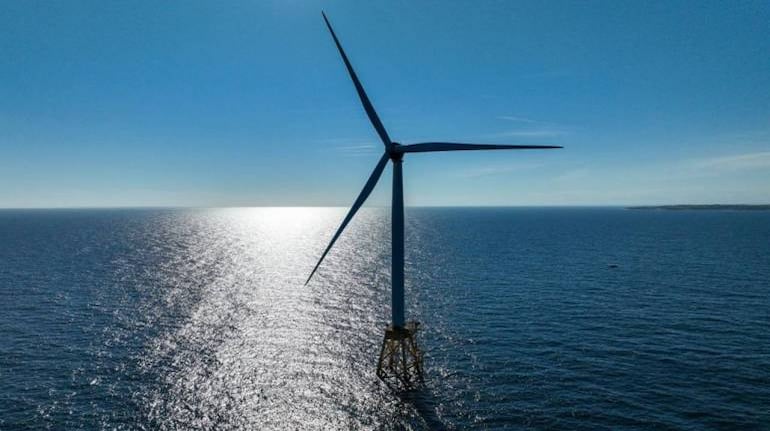



he falling cost of renewable energy has been one of the great success stories of our time. Not only does it make greening the planet affordable, it also encourages ambitious goals. Learning by doing has pushed a declining cost curve that optimists hope will apply to carbon removal, small modular designs for nuclear reactors, battery technology and more.
That’s why it’s particularly bad news that the price of solar, and especially offshore wind projects, is now going up rather than down.
Part of the story is macroeconomic. Wind and sunshine are free, whereas gas-, coal-, and oil-fired plants need fuel. That means the price of renewable electricity is almost entirely determined by the upfront cost of building the facility, whereas fossil-fuel energy prices are a mix of upfront costs and ongoing fuel costs. Higher interest rates, as the US and other countries are now experiencing, raise the upfront costs of capital projects.
Renewables have also been hurt by broader inflationary dynamics. The cost of raw materials and construction labor has gone up. And to an extent, the industry has been hurt by its very growth, which is not restricted to one country or region but is global.
The current squeeze is particularly acute in the field of offshore wind projects, which are extremely important to the energy future of the northeastern US. These are places with progressive politicians who want to decarbonise, but they’re not as sunny as California and they don’t have the wide open spaces of the plains to deploy utility-scale onshore wind.
What they do have is ample coastline and in many cases relatively minimal competing uses. New York, in particular, is also counting on offshore wind power to help make up the gap caused by the closure of the Indian Point nuclear plant. The developers of those offshore proposals are now asking the Public Utility Commission for more money — citing the need to cover the higher costs of inflation, but also knowing that the PUC doesn’t necessarily have a choice if the state wants to meet its clean-energy goals.
Up the coast in Rhode Island and Massachusetts, offshore wind projects are getting canceled due to rising costs and a reluctance to pass along higher rates to customers.
Some of this is bad luck and basic growing pains. The war in Ukraine has raised the cost of steel, and there were probably just too many planned offshore projects globally to all be executed at once. But in the US, competing and overlapping policy demands have exacerbated the problem.
The Jones Act, which requires the use of US-flagged and US-crewed ships for most of this work, is making offshore projects more expensive than they need to be. Critics have been warning for years that the scarcity of Jones-compliant ships would mean fewer and more expensive wind projects than President Joe Biden’s administration is counting on — but nothing has been done about it even as other sources of cost escalation have rocked the industry.
Democrats have tended to see wind projects as an opportunity for union-friendly contracts on shore as well as off — with Maine requiring the use of pricey factory labor in constructing the turbines before assembly. In July the Biden administration even bragged about one project off the shore of New Jersey that was “expected to create more than 3,000 good-paying jobs” and be “built by union labor.” Last week the Danish company that’s supposed to build the project threatened to abandon it (and other US offshore projects) unless additional subsidies are forthcoming.
Fundamentally, the administration needs a climate policy that takes into account its own successes in achieving full employment. The great triumph of Bidenomics is that the US rapidly pulled itself out of the pandemic slump and avoided the kind of slow, grinding recovery that plagued Barack Obama’s presidency. But with so few unemployed workers, a policy designed to “create jobs” just ends up reallocating workers from one sector to another.
If it’s possible for the administration to achieve its climate goals with fewer workers — perhaps by employing foreign ships or importing foreign goods — then it should favor that. But if its policy pushes up the cost of delivering new renewable projects, then the US is going to end up with either less renewable energy or higher electricity costs. The government can try to plug the gap with subsidies, but that will only further drive up the budget deficit and interest rates, which encumbers renewable projects relative to fossil fuels.
We’re stuck in a world of tradeoffs precisely because unemployment is low and the economy is firing on all cylinders. That’s mostly good — but it means that climate policy needs more rigor. It’s wrong to assume renewable costs will inevitably fall and treat projects as piggybanks. Progress on costs happens when there is a good-faith effort to improve efficiency.
Matthew Yglesias is a columnist for Bloomberg Opinion. A co-founder of and former columnist for Vox, he writes the Slow Boring blog and newsletter. Views are personal and do not represent the stand of this publication. Credit: BloombergDiscover the latest Business News, Sensex, and Nifty updates. Obtain Personal Finance insights, tax queries, and expert opinions on Moneycontrol or download the Moneycontrol App to stay updated!
Find the best of Al News in one place, specially curated for you every weekend.
Stay on top of the latest tech trends and biggest startup news.